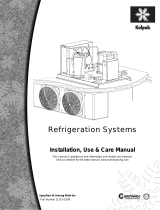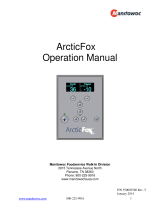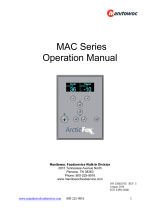Page is loading ...

1 | Page w w w . p a t t o n n z . c o m
PATTON UNIT COOLERS
INSTALLATION, OPERATION &
MAINTENANCE MANUAL
TC SERIES
The installation and start-up of Unit Coolers should only be performed by qualified refrigeration engineers/mechanics. Electrical
connections must be performed by suitably qualified personnel. The equipment should be installed in accordance with all applicable codes,
ordinances and local by-laws. Units are designed for refrigeration and/or air-conditioning systems utilising only the specified refrigerant
fluids as per technical documentation.
INSPECTION
Inspect all equipment before unpacking for visible signs of damage or loss. Check order list against models received to ensure shipment is
correct and complete.
IMPORTANT: Remember, you, the consignee, must make any claim necessary against the transportation company. Shipping damage or
missing parts, when discovered at the outset, will prevent later unnecessary and costly delays.
If damage or loss during transport is evident, make claim to carrier, as this will be their responsibility, not the manufacturers. Should
carton be damaged, but damage to equipment is not obvious, a claim should be filed for “concealed damage” with the carrier.
IMPORTANT: The electrical characteristics of the unit should be checked at this time to make sure they correspond to those ordered and to
electrical power available at the job site. Save all shipping papers, tags and instruction sheets for reference by installer and owner.
LOCATION
Determine the best location for the unit cooler in the space to be refrigerated. The unit location in the cabinet should be selected to ensure
uniform air distribution throughout the entire space to be refrigerated. Be sure that the unit does not draw air in, or blow directly out
through an opened door and that the stored product does not obstruct the free circulation of air.
Leave sufficient space under the unit to allow service of the drain tray and to access other components.
Consideration should also be given to minimize the piping run length to the condensing unit and drain outlet.

2 | Page w w w . p a t t o n n z . c o m
I, O & M Manual Cont’d.
TC Series
MOUNTING
TC Series unit coolers are supplied for hanging via sheet metal baseplate. (Mounting centres as per Figure 1 and Table 1). Ensure all
mounting holes are utilised and in general mount unit flush to cabinet ceiling. Remove all packaging prior to positioning.
Figure 1.
Models
TCM03
TCM04, 06, 08
TCM10
TCM12, 16
(L) Overall Length (mm)
604
604
604
804
(D) Overall Depth (mm)
386
386
386
466
(H) Overall Height (mm)
156
178
200
208
Table 1.
CLEARANCES
This evaporator draws air through the fan and discharges from the coil side, thus adequate clearance should be made on the entering grill
of the fan to ensure even unrestricted air flow through the coil. This distance should be approx. equal to the height of the coil or more.
Ensure enough room is left below and at the ends of the unit for servicing.
DRAIN LINE
If the evaporator is mounted flush to ceiling and level, the drain connection at either end is suitable for positive drainage. If unit is pitched
on an angle ensure drainage point is from lower fitting. If units are suspended below the ceiling, the installer must provide adequate pitch
to the unit by adjusting the hangers.
Note: Check for adequate drainage by pouring water into the drain pan. Ensure that the drain pan has sufficient slope for proper drainage
(prevention of ice build-up/blockage in pan).
Tube should be run from the drain connection, sloping at least 300mm per meter. A trap located outside of the cabinet should be provided
to prevent warm air entering through the tubing. Connection should be made to proper drainage facilities that comply with local
regulations.

3 | Page w w w . p a t t o n n z . c o m
I, O & M Manual Cont’d.
TC Series
PIPING
Refrigerant line sizes are important and may not be the same size as the coil connections (depends on the length of run). If in doubt,
consult “Recommended refrigerant line size” charts or equivalent software.
Expansion Valve. (If used)
Expansion valves are to be installed in accordance with the valve manufacturers recommendations. The external equaliser line must be
connected. Proper location of the sensing bulb is extremely important to coil performance and good thermal contact to suction line is
essential.
Note: Sweat expansion valve installation –
Remove internal components.
Wrap valve body with a damp cloth when brazing.
Use low melting point solder.
Direct flame away from valve body to prevent overheating.
WIRING
Wire system in accordance with governing standards and local codes. Supplied typical wiring diagrams are for reference only. Refer to
unit data plate for operating current and nominal voltage.
Unit end panel provides quick access to the electrical compartment. For ease of identifying the proper wiring terminals, unit wiring where
possible is colour coded and terminal block connections are identified.
SYSTEM CHECK
Before Start-Up:
All wiring should be in accordance with local codes.
All refrigerant lines should be properly sized.
Thorough evacuation and dehydration has been performed.
The suction, discharge and receiver service valves must be open.
The system should include a liquid line drier complete with moisture indicator.
Pour enough water into the drain pan to allow a good check on drainage and seal the trap.
After Start-Up:
Be sure that the expansion valve is properly set to provide the correct amount of superheat.
Heavy moisture loads are usually encountered when starting the system for the first time. If the coil temperature is below
freezing, this will cause a rapid build-up of frost on the coil. During the initial pull down, frost build-up should be monitored and
defrosted manually if required.
Check for correct unit cooler fan blade rotation.

4 | Page w w w . p a t t o n n z . c o m
I, O & M Manual Cont’d.
TC Series
MAINTENANCE
Note: Before performing maintenance make sure the power supply is isolated and/or rendered safe.
Patton Unit Coolers, in general, are maintenance free. However conditions of application subject equipment to differing levels
of contaminants and corrosive exposure, therefore it is the operating companies responsibility to evaluate the checking periods
required and/or the actions needed to ensure correct operation. Following is a proposal checklist for periodic inspection.
1. Visual inspection of brackets and fastenings.
2. Inspection and check of tightness on all electrical terminals.
3. Check condition of electrical cables (cuts and/or sheathing degradation).
4. Check earth connection using appropriate equipment.
5. Inspect heat exchanger (coil) for build-up of return air side contaminants/dust/dirt and clean if necessary. Only use cleaning
agents compatible with unit materials and consider the manufacturers application instructions (e.g. mixing ratios, exposure
times, after treatment, food-grade applicable if required, etc).
6. Visual inspection of the heat exchanger (coil) for ice build-up.
7. Check the functionality of the defrost system (electrical) if present.
8. Check the functionality of the safety systems (heater klixons) if present.
9. Check the functionality of the condensate drain and ensure free drainage of water.
10. Check for correct operation of expansion device (superheat setting of TXV etc)
11. Check electric fans for cleanliness, correct rotation, current draw, blade integrity etc.
12. Other checks as may be determined by the application or individual requirements.
Due to Patton Ltd’s policy of continuous improvement we reserve the right to make changes without notice.
/






